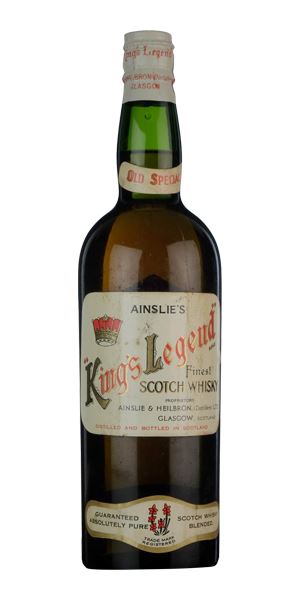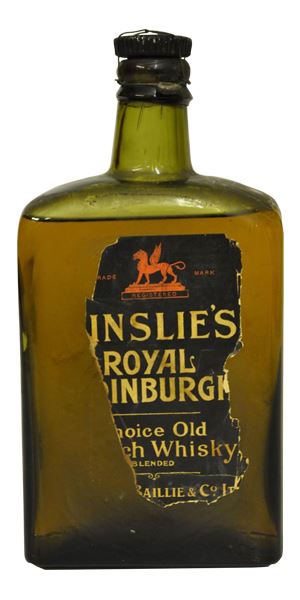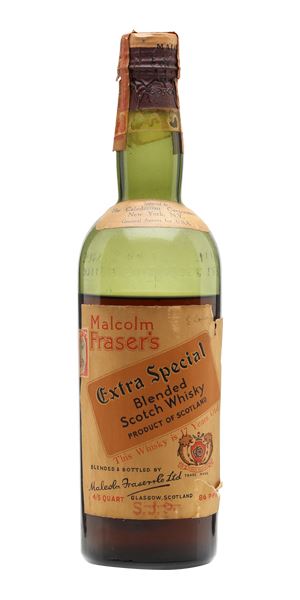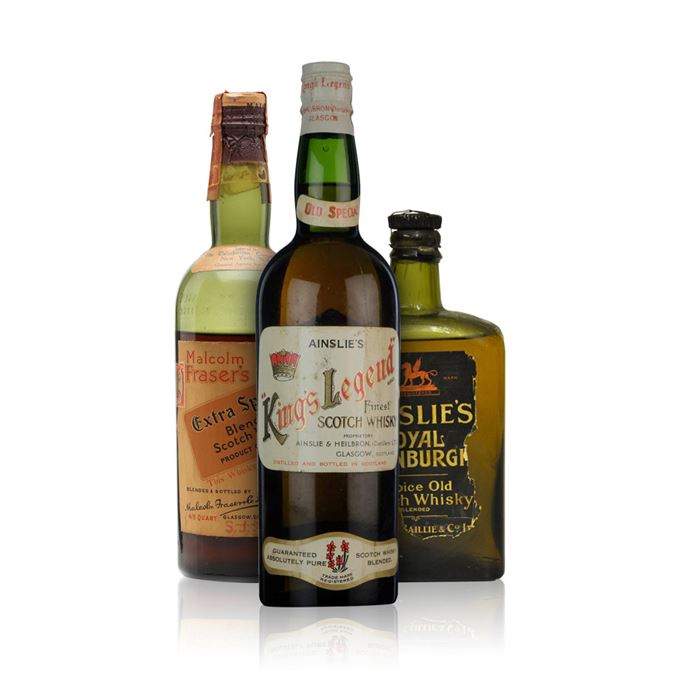-

- Price band
-
£ £ £ £ £
- ABV
- 43%
- Production type
- Blended Scotch whisky
- Region
- n/a
- Flavour camp
- Rich & Round
- Nose
Lots of oily soot and metal polish to begin with. Some undercurrents of mashed potatoes, asparagus and black pepper as well. This rather typical ‘spring cap’ aroma that demonstrates the olfactory tension of ‘old bottle effect’ and the more robust, old-style malt content of the blend still fighting after all these years in bottle. In this instance there’s enough coal hearth, old wax paper, lamp oil and sack cloth to balance out these notes of old copper coins and hot iron fillings. The longer it sits in the glass, the nicer, and cleaner, it becomes. A little dry, earthy peat starting to emerge.
- Palate
Tricky. It’s rather dusty and sooty and very dry to the point that it’s verging on overtly cardboardy. It’s not without residual punch but there probably had been a diminishment of power over time. Lots more metal polish, oily rags, paraffin, old coins and a touch of wood glue. Some nods towards a formerly more taught and punchy mineralic structure. But you can’t escape the fact this is a bit faded, dry and cardboardy. Fairly classic OBE and spring capsule characteristics.
- Finish
Still rather long but slightly acrid with notes of putty and plasticine – a resurgent vegetal aspect as well.
- Conclusion
Treads an extremely fine, and at times rather melancholy, three-way tight rope between good, interesting and out of condition. A big weighted quilt of old bottle effect, underneath which there’s a wonderful old, Clynelish-hearted whisky trying to fight its way free. A tough one to score as you keep thinking it’s going to break free and soar but it never quite manages it.
- Right place, right time
Putting an old friend in the ground; one dram for you and the rest for the earth.
Image courtesy of whisky-onlineauctions.com.

- Price band
-
£ £ £ £ £
- ABV
- 40%
- Production type
- Blended Scotch whisky
- Region
- n/a
- Flavour camp
- Fruity & Spicy
- Nose
A different world. This possesses an almost leathery and syrupy waxiness. Old pots of vapour rub. Herbal resins, cannabis oil, high strength American IPA, a sense of pinecones and fir liqueur. Many oils and resins, some motor oil, an old tool box and a light saline minerality as well, like beach pebbles. Continues with clay, aged ointments, crushed aspirin, carbon paper and old furniture. Wonderfully complex and with a staggeringly resilient power.
- Palate
Mouth-slathering oiliness. Fat, textural and with a rising fug of dense, earthy, drying peat, like bonfire embers, lanolin and medical antiseptic. More waxes, eucalyptus oils, a little natural tar liqueur and some hessian and camphor. You can only imagine the kinds of malts that have marinated in the depths of this liquid for the best part of a century. Despite the malt component’s obvious muscle and volume, the grain is there as well: these slightly thinner notes of green apple peelings, mustard powder and acidic cider.
- Finish
Long, superbly herbal, earthy and full of things like engine grease, rapeseed oil and dried parsley. A lingering nod to some ancient yellow Chartreuse.
- Conclusion
I would bet precious things that there’s a hefty dollop of old Clynelish in this baby. Although, as with so many of these really old, pre-wartime blends, you are left with the impression of just how much fatter and more textural the broad style of Scottish malt whisky was in this era. A heartbreaking wee marvel, spat out of a time warp...
- Right place, right time
The sort of bottle that should be cracked at the re-opening of old Clynelish – sometime around 2020. That should give you time to find another one...
Image courtesy of whisky-onlineauctions.com.

- Price band
-
£ £ £ £ £
- ABV
- 43%
- Production type
- Blended Scotch whisky
- Region
- n/a
- Flavour camp
- Smoky & Peaty
- Nose
Magnificent peat. Almost like a pure distillation of herbs, peat and wood resins. Practically crystalline in its purity. Stunning, leafy, slightly salty Sherry alongside this sweet, simmering unctuous, old-style organic peatiness. You could also add some orange peel, menthol gum, spiced marmalade and pine resin. Tarry, luxuriously textured, perfectly layered and composed, and hauntingly seductive. The kind of old-style peaty aroma that’s just to die for. Could almost be a 1940s Highland Park!
- Palate
Only just clinging to life in terms of strength but the flavours are still there. The oxidisation has left the peat intact but wafer thin, exposing a pure coconut flavour – one that feels derived from old American oak transport Sherry casks, allied as it is to these darkly fruity and rather dry, salty old oloroso notes. There’s salty liquorice, many dried herbs, some old beef stock, soot and blasts of warm kiln air and hessian. There’s a tiny glimmer of raisiny sweetness and some yellow sultanas as well. Not a glimmer of grain in sight in this one.
- Finish
Miraculously long and still breathtakingly peaty. A billowing waft of old, heathery peat smoke, warm kilns, slightly greasy and kippery and again with this syrupy, peaty sweetness.
- Conclusion
I would do terrible things to possess a bottle of this with a well-preserved filling level. It says a lot about the quality and power of a whisky that it can dip so low naturally in the bottle and retain such monumental flavour and composure. Even though you feel the alcohol has really fallen away on the palate, the flavours remain and the nose is just totally exquisite. The kind of blend that makes you wonder if it was really actually a blend. And the kind of whisky that is a textbook example of a manifestation of peat flavour in whisky that is long extinct. The weakness prevents me from going higher but at full power we’d be approaching 94 points I expect.
- Right place, right time
Watching The Godfather Parts I and II back-to-back with a couple of magnificent cigars, an even more magnificent pal by your side and second bottle of the same whisky close at hand.

For this week’s tasting Angus MacRaild returns to the world of old blends to see how whisky flavour develops and changes in the bottle, and how they can give as a glimpse into the character of malt whisky from bygone eras.
MacRaild begins with the first of a pair of old Ainslie’s blends, a brand renowned for using Clynelish as a major component. The first is a 1950s Ainslie’s King’s Legend, which was sealed with a spring cap. However MacRaild notes that these capsules, while effective at preserving a bottle’s fill level, can taint their bottle’s contents after several years, manifesting in excessively metallic, vegetal, sometimes acidic and cardboardy taste. MacRaild finds a degree of all these aspects in the King’s Legend, but also a sense of the original character and potency of the whisky within.
Much more satisfying is the even rarer Ainslie’s Royal Edinburgh, which was bottled sometime between 1913 and 1921 when the brand was owned by Ainslie Bailley & Co. Ltd of Leith. MacRaild finds it to be a ‘heartbreaking’ time capsule of early 20th century flavours, and notes how cork is a better preserve of a whisky’s quality and character over the decades, despite allowing for a little more evaporation.
A bottle of Malcolm Fraser’s Extra Special 17-year-old blended Scotch rounds things off. This whisky was bottled for America in the late 1940s, with its lead foil seal indicating it was bottled after the war when excess metal was no longer prohibited from non-essential use. Interestingly, this bottle had lost a significant amount of its filling level, meaning the alcohol had dipped noticeably. MacRaild marvels at the retention of flavour and character in spite of this evaporation – not to mention the old-style intensity of the peat flavour.

